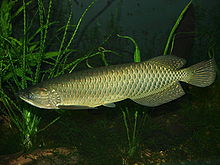Osteoglossidae
| Osteoglossidae Temporal range:
| |
|---|---|

| |
Scleropages leichardti, a fish endemic to Queensland
| |
| Scientific classification | |
| Domain: | Eukaryota |
| Kingdom: | Animalia |
| Phylum: | Chordata |
| Class: | Actinopterygii |
| Order: | Osteoglossiformes |
| Suborder: | Osteoglossoidei |
| Family: | Osteoglossidae Bonaparte, 1831 |
| Genera | |
|
See text for extinct taxa | |
Osteoglossidae is a family of large freshwater fish, which includes the arowanas and arapaima. They are commonly known as bonytongues. The family contains two extant subfamilies
Osteoglossinae, with a total of five living genera.[1] The extinct Phareodontinae are known from the Late Cretaceous and Paleogene.[2]
Osteoglossids are
extant species from South America, one from Africa, two from Asia, and two from Australia.[3] Although currently restricted to freshwater habitats in the tropics, the group was much more widespread during the Cretaceous and Paleogene, with genera known from North America and Europe, including marine taxa such as Brychaetus. An indeterminate marine osteoglossid is known to have inhabited the seas around Greenland in the Early Paleocene.[4] The earliest known osteoglossid is Cretophareodus from the middle Campanian of the Dinosaur Park Formation
, Canada.
The following taxa are known from the family:[2][5][6][7]
- Family Osteoglossidae
- Genus ?†Chauliopareion (possibly a basal osteoglossiform)[2]
- Genus ?†Singida (possibly a basal osteoglossiform)[2]
- Subfamily Arapaiminae
- Genus Arapaima
- Genus Heterotis
- Genus ?†Joffrichthys (possibly a basal osteoglossiform)[8]
- Genus †Sinoglossus
- Genus †Thrissopterus
- Subfamily Osteoglossinae
- Genus Osteoglossum
- Genus Scleropages
- Subfamily †Phareodontinae
- Genus †Brychaetoides
- Genus †Brychaetus
- Genus †Cretophareodus
- Genus ?†Foreyichthys
- Genus †Furichthys [2][7][9]
- Genus ?†Heterosteoglossum
- Genus †Macroprosopon[10]
- Genus †Magnigena
- Genus †Monopteros
- Genus †Musperia
- Genus ?†Opsithrissops
- Genus †Phareoides
- Genus †Phareodus
- Genus †Phareodusichthys
- Genus †Ridewoodichthys
- Genus †Taverneichthys
- Genus †Xosteoglossid
References
- ^ "Arapaim availability". Britannica. Retrieved 1 February 2022.
- ^ ISSN 1679-6225.
- ISBN 0-7307-5486-3.
- ISSN 2056-2799.
- ISSN 1092-6194.
- ISSN 0305-8719.
- ^ a b Capobianco, Alessio (2021). Paleontological Data Reveals Unexpected Biogeographic Histories of Extant Organisms: Bonytongue Fishes (Teleostei: Osteoglossomorpha) as a Case Study (Thesis thesis).
- ISSN 0024-4082.
- ISSN 0024-4082.
- ISSN 0024-4082.
